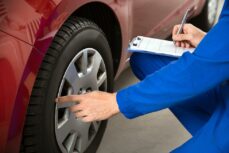Tyre rotation: useful instruction guide

When and how often should you rotate your tyres?
Rotate your tyres once a year or every 10,000 km
Provided you rotate your tyres once a year or at approximately every 10,000 km, the rubber on all four of your tyres will tend to wear down at pretty much the same rate and much more evenly. You can estimate the proper time interval to rotate your tyres by factoring in the anticipated service life of the tyres: we recommend swapping your tyres at intervals equivalent to 1/3rd of the manufacturer’s recommended service life.
Rotate your tyres when the wearing process begins
For example, in the case of a tow car, the rear tyres will normally wear out quicker. That means when the front tyres on the vehicle begin to show signs of wearing, swap the front tyres with the rear ones to extend their life. Of course, this action is only a viable option if you perform the switch in sufficient time before any serious wear occurs. Naturally, if your tyres are badly worn, you should always replace them with new tyres rather than just swapping them over.
Tyre rotation: instructions
How should you rotate symmetrical tyres on a towing vehicle?
The vast majority of company vehicles are towing vehicles, i.e., equipped with front-wheel drive and symmetrical tyres. In this case, the front tyres tend to wear out faster than the rear set. So rotate the tyres crosswise (in a diagonal direction):
- exchange the rear right-side tyre with the front left-side tyre;
- exchange the rear left-side tyre with the front right-side tyre.
How should you rotate symmetrical tyres on a front-wheel-drive vehicle?
In the case of a front-wheel-drive vehicle, the rear tyres must assume the same position on the axle when transferred to the front. Move the front wheels to the rear and also change sides at the same time:
- the rear right-side tyre moves to the front right;
- the rear left-side tyre moves to the front left;
- the front right-side tyre moves to the rear left;
- the front left-side tyre moves to the rear right.
How should you rotate symmetrical tyres on a four-wheel-drive vehicle?
With a four-wheel-drive vehicle, the front tyres move back to take the place of the rear tyres without changing sides. The rear tyres move forward and change sides on the axle simultaneously.
Good to know: if your spare wheel is the same type as the other full-size tyres, you can also add it into the tyre rotation sequence. For example, you can swap the front left-side tyre with the spare wheel and then proceed with the remaining tyres as mentioned above for towing vehicles, front-wheel-drive vehicles and four-wheel-drive vehicles.
What should you do if you have asymmetrical or directional tyres?
Asymmetrical tyres have a special feature: these tyres combine two different kinds of tread patterns on the inner and outer sides of the tyre. If your tyres have a tread with a directional pattern, you can only change the ones on the same side. In both situations, you can only swap the front tyres for the rear tyres while keeping the same respective positioning on each axle — you can never change these tyres from side to side.
What should you do if your vehicle’s tyres are of varying sizes?
If your front tyres are not the same size as your rear tyres, then you cannot swap them one another. In this scenario, all that is possible in terms of rotation is to swap the left and right tyres on the same axle, provided, of course, that both tyres are symmetrical.
The axle-by-axle tyre rotation is a simple and effective means of ensuring that all your tyres wear evenly. In turn, this ensures they will continue to provide you with good grip when driving and make the complete replacement of all the tyres much less necessary! So, remember to check your tyres regularly for wear and tear, and always take into account your vehicle’s type of drive and the type of tyre it comes equipped with when swapping them over.














